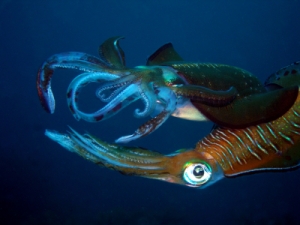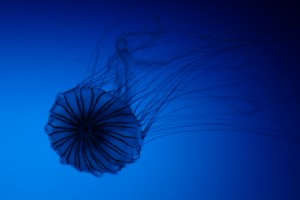Jellyfish Fantasy Hall or The Rise of Slime?
Enter the Jellyfish Fantasy Hall at Enoshima Aquarium south of Tokyo and you will find yourself surrounded by dazzling swarms of gently pulsating creatures… Jellyfish, which have inhabited the world’s oceans in one form or another for over one billion years, come in a dizzying array of shapes, sizes and colors.
– from Pink Tentacle
It’s an interesting time to be celebrating these Ophelia-esque critters who mark so many things, from alien beauty to changing oceans (beautiful horror/reality in this LA Times editorial on “Altered Oceans“). It’s not surprising to find that the phrases “The Rise of Slime” or “Invasion of the The Jellyfish Blooms” read like science fiction.
Rising temperatures in the oceans are a root cause of these blooms, attributable to ocean acidity levels, toxic sewage and animal waste runoffs, fertilizer dumping (fish or land farming), overfishing and other pollutants. “The Rise of Slime,” a return to primordial oceans, is one descriptor of a Dead Zone, a drastic reduction in the ocean’s oxygen levels. Jellyfish are one of the only animals who can thrive in this climate.
The EPOCA/Ocean Acidification blog sums it up nice and heavy:
“They are calling it “the other CO2 problem”. Its victim is not the polar bear spectacularly marooned on a melting ice floe, or an eagle driven out of its range, nor even a French pensioner dying of heatstroke. What we have to mourn are tiny marine organisms dissolving in acidified water.
In fact we need to do rather more than just mourn them. We need to dive in and save them. Suffering plankton may not have quite the same cachet as a 700-kilo seal-eating mammal, but their message is no less apocalyptic. What they tell us is that the chemistry of the oceans is changing, and that, unless we act decisively, the limitless abundance of the sea within a very few decades will degrade into a useless tidal desert.”

Link to some info on the Gulf of Mexico Dead Zone, currently the largest in the world.
Link to more general information about Dead Zones and the jellyfish connection
The Anthropocene Era (1)
New geological ages are characterized by changes in global environmental conditions and large scale shifts in types of species. Recently Earth has entered into a new geological age: The Anthropocene, from anthropo / man and cene / new [geological age]. Humans are now changing the world on a global scale and ushering in the new era in geologic time.
– Oceanography in the 21st Century
It has no precise start date, but may be considered to start in the late 18th century when the activities of humans first began to have a significant global impact on the Earth’s climate and ecosystems. This date coincides with James Watt‘s invention of the steam engine in 1784. The term was coined in 2000 by the Nobel Prize winning atmospheric chemist Paul Crutzen, (who unpacked the process of atmospheric ozone depletion) who regards the influence of human behavior on the Earth in recent centuries as so significant as to constitute a new geological era.
– Wikipedia
Geologists from the University of Leicester propose that humankind has so altered the Earth that it has brought about an end to one epoch of Earth’s history and marked the start of a new epoch – the Anthropocene.
They have identified human impact through phenomena such as:
• Transformed patterns of sediment erosion and deposition worldwide
• Major disturbances to the carbon cycle and global temperature
• Wholesale changes to the world’s plants and animals
• Ocean acidification
The scientists analysed a proposal made by Nobel Prize-winning chemist Paul Crutzen in 2002. He suggested the Earth had left the Holocene and started the Anthropocene era because of the global environmental effects of increased human population and economic development.
The researchers argue that the dominance of humans has so physically changed Earth that there is increasingly less justification for linking pre- and post-industrialized Earth within the same epoch – the Holocene.
– from Paleoblog
The Humboldt Squid
The Humboldt squid has 36,000 teeth in total. Moves fast. Eats dirty. Is big. Gorgeous, graceful, and alien creature.
“The Humboldt squid is a voracious predator that will eat anything it can get its tentacles on.” – livescience.com

Creatures of a new mythology. Moving up and down the water columns. Ecosystem parasites. Opportunists. Formidable monsters. Predators. I say monsters, because with climate change the Humboldt squid “substantially expanded its perennial geographic range in the eastern North Pacific by invading the waters off central California. This sustained range expansion coincides with changes in climate-linked oceanographic conditions and a reduction in competing top predators. It is also coincident with a decline in the abundance of Pacific hake, the most important commercial groundfish species off western North America.” – National Academy of Sciences
The squid are expanding their range vertically, in terms of depth and horizontally in terms of range, and eating away their prey. They are competing for our food, having outlasted their competing predators and exhibiting robust resistance to changing conditions.
Monsters represent a threat to our safety and livelihoods. They are our wily and flexible competitors.

Capt. Charles Moore on the seas of plastic | Video on TED.com
Charles Moore is founder of the Algalita Marine Research Foundation, one of the first to trawl the Garbage Patch. He captains the foundation’s research vessel, the Alguita, documenting the largest “landfills” of plastic waste that litter the oceans.
“A yachting competition across the Pacific led veteran seafarer Charles Moore to discover what some have since deemed the world’s largest “landfill” — actually a huge water-bound swath of floating plastic garbage the size of two Texases. Trapped in an enormous slow whirlpool called the Pacific Gyre, a mostly stagnant, plankton-rich seascape spun of massive competing air currents, this Great Pacific Garbage Patch in some places outweighs even the surface waters’ biomass six-to-one.”
Souvenirs from the Great Pacific Garbage Patch

When I was digging around for Paradoxical Sleep, I wanted to find out what happened after San Jose’s Guadalupe River, after the South Bay of Northern California. The whirling gyre of nasty pollution information literally culminated in this vortex: The North Pacific Garbage Patch, an area the size of Texas that’s a confluence of ocean currents, north of Hawaii. Maybe it’s twice the size of Texas: it’s an undulating swirling mass; it’s a soup of industrial and consumer plastics; some are plastic pellets from manufacturing, small enough to be mistaken for plankton and eaten by marine animals; lots are large enough to comprise a bounty in a net haul.


